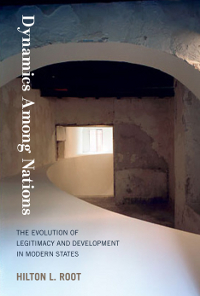 As part of USAPP’s first Book Review Forum, Hilton Root responds to comments from the LSE’s Peter Trubowitz on his recent book, Dynamics among Nations. He argues that changes in the structure of global networks are becoming more able to connect countries and their resources, without the influence of a large hegemon like the US. This means that we are now seeing the end of hegemony as a source of global order, whether those in the US are motivated towards liberal internationalism or not.
As part of USAPP’s first Book Review Forum, Hilton Root responds to comments from the LSE’s Peter Trubowitz on his recent book, Dynamics among Nations. He argues that changes in the structure of global networks are becoming more able to connect countries and their resources, without the influence of a large hegemon like the US. This means that we are now seeing the end of hegemony as a source of global order, whether those in the US are motivated towards liberal internationalism or not.
 Dynamics among Nations: The Evolution of Legitimacy and Development in Modern States. Hilton Root. MIT Press. November 2013.
Dynamics among Nations: The Evolution of Legitimacy and Development in Modern States. Hilton Root. MIT Press. November 2013.
In his review of Dynamics among Nations, Professor Peter Trubowitz makes an essential point that the demand for a liberal hegemon far exceeds the supply and I would like to expand on it. We share apprehension that the conception of political stability that encompasses democratic governance and market economies is in trouble. Trubowitz emphasizes the declining motivation of the American public to bear the costs for maintaining the system. He implies they fail to see the urgency because they underestimate the risks and need better-informed policy analysis to rectify their failure of judgment. I fully concur with this observation. I would like to take the discussion further by asking what contributes to the decline of those motivational drivers. I will focus on the changing networked behavior within the international system that determines influence and power, and on an inability to prevent unintended consequences, such as anti-American blowback and the entrenchment of undemocratic rule, that resulted from previous interventions.
Changing network structure
A fundamental, system-level, reason explains why the demand for liberal internationalism exceeds the supply. Changes in the structure of global networks have altered the properties of the system barring the power of hegemony from being exercised. Hegemony is premised upon the concentration of hierarchical properties essential to power being concentrated within a single nation through that nation’s control of flows of diplomatic/cultural, technological, trade and defense related resources.
During the cold war the US and the Soviet Union, both hegemons in their respective domains, enjoyed the powers of being the central node in a relatively closed system of relationships with dependent powers. Think of the nodes as the actors or nations in the system. Actors can gain power if one or more of the other actors depend on them for access to any of these flows, and if they can choose to exclude them.
To measure a nodes centrality four properties are essential; the degree of how connected it is, closeness to other nodes, betweeness in connecting other nodes and the neighborhood characteristics of the network. A node may gain power from betweeness, if it sits between multiple others actors and is an essential conduit of communication and coordination. However, if the flow of resources may follow multiple alternative paths, control over just one of those paths yields less power.
The US and the Soviet Union once were the indispensible node between the other nodes in their network enjoying authority derived from betweeness, dependence and exclusion: both had the ability to deter access to essential resources.
This power of exclusion made common membership in one of the two giant components of the larger global network essential for diplomatic leverage in the UN, access to natural resources and high-end manufactured goods, knowledge and large consumer markets. Individual countries could be connected to each other by virtue of belonging to one camp or the other. Leadership of dependent regimes could expect to be rewarded with support from the hegemon either to repress popular insurgencies or to defend borders. This made being a hegemon or being a dependent both viable and highly profitable.
Hegemony requires that the central node is the shortest path between any two other nodes but today the number and size of alternative cliques from whom resources can be obtained have increased. The path length or diameter that constitutes the distance between nodes has shortened. Many more countries are now directly connected to each other and do not have to depend on a hegemon to obtain critical resources. These changes in the density of connectivity and in the dissemination of technological capability have transformed the structure of global political economy from being a traditional hierarchy or pyramid, to that of a network in which any part can link with any other. The erosion of the hegemon’s role as the essential pivot can be observed in many of the global networks that bestow power, such as business relations, arms distribution and diplomatic influence. Increased network density diminishes the payoffs of being a hegemon with many implications for the exercise of power within the system.
New clusters have formed that can exercise greater autonomy. One of these clusters with links to China appears to be a random network with few positive sources of linkage, yet it has the potential to be a new giant cluster. As the giant component of a network grows in size a threshold is reached when the giant component can swallow more of the nodes in the system. At that point the many branches of what was previously a random network become connected.
These changes in the density of global networks are not being captured in the popular debates that mostly presume that if one nation is in decline another must be raising. Hence there is much discussion about China’s or Russia’s strategy to assume that share of power once exercised by the US. But wannabe, emerging powers must face the same constraints the US now faces; the power of centrality has eroded. No one is going to take over, as Georgetown Political Scientist, Charles Kupchan remarks; it is no one’s world. Chapter 11 of Dynamics among Nations announces, there is no “Captain at the Helm” and this will make it more difficult to obtain consensus on potentially divisive issues of global governance.
Professor Trubowitz observes, that this is certainly a more dangerous world and I wholly concur. In such a world nations will be more likely to pursue their own interests with little concern for their actions impact the cohesion or sustainability of the system. We differ on our understanding of declining motivation, which Trubowitz seems to imply is the main source of the deficit of hegemony. I view the shortage in the supply of hegemony as an intrinsic property of the system. Since the networks for the distribution of commodities or resources have become more diffuse a centrally situated power can no longer exercise the power of exclusion.
Declining motivation for liberal internationalism
Trubowitz points out that an essential component of liberal internationalism, open markets, is incurring widespread disillusion. The US public equates trade openness with the loss of jobs to offshore sites. They ask, why open further to those very economies that are stealing our jobs? This narrative, Professor Trubowitz observes, dampens enthusiasm for expanding trade initiatives with Asian economies. The public sees the risk to employment, not the larger risk of China’s growing power. Thus we lose a powerful tool that would discourage China from converting its economic wealth into geopolitical power. Expanded trade integration would reduce the impetus for our allies to look elsewhere to grow their economies, heightening our security and that of the region. All agree on this. Trubowitz infers better information about the risks will bring a necessary change in resolve. I also wish this was the case but I believe this dearth of motivation reflects the changing position of the US within the larger structure of international relations. Britain in the nineteenth century and the US after WW II were motivated to maintain liberal relations within the larger system only so long as they received a commensurate albeit larger share of the value. In the past the national state at the top of the liberal hierarchy lost its motivation to commit resources to protecting system stability when this compensation was dissipated.
In sum, network structure confers the power for any single nation to act as a hegemon but when the distance between the subsidiary nodes diminishes, the influence exercised by the central node is also reduced. This means the end of hegemony as a source of global order.
The US derived motivation to administer the system because of its commitment to a global ideology of spreading liberal polities around the world and a belief that liberal nations would be more peaceful neighbors. That belief endures, but the ability to turn it into actionable, purposeful policy has declined.
Let me conclude with a final concern not directly addressed in Dynamics among Nations but relevant to our discussion.
Unintended consequences of intervention
An important source of disillusionment with active support for liberal internationalism is frustration with the relative ineffectiveness of previous interventions and the inability of policy makers to predict, prepare for or prevent unintended consequences from reoccurring.
US globalism requires a new script that the Obama administration promised but did not deliver. America’s cold war alliances often resulted in increased political and social instability among alliance partners. During the cold war asymmetrical alliances created a development trap and reduced the incentives for local leadership to govern for prosperity. The domestic failures of allied governments drew the US into regional conflicts and Wars in Korea and Vietnam in the name of containing Communism. After 9/11 the same pattern of forging alliances with corrupt or unpopular regimes in Iraq and Afghanistan failed to produce ostensible, lasting benefits. Obama claimed to recognize this trap in his campaign rhetoric, but has failed to avoid it.
The interventions of the Bush and Obama administrations in Central Asia have produced anti-American policy setbacks that create new unintended security risks. Again in the name of defending liberty the US finds itself supporting rulers who govern personally and autocratically, often in pursuit of interests that directly clash with US interests and values. As I discusses in my 2008 book, Alliance Curse, when rulers we support become targets of resentment by their own populations, the alliances will send blowback to US shores in the form of unanticipated threats. The advocates of a more active foreign policy can offer no assurances that future interventions will not once again unleash unintended consequences creating new risks often greater than those the intervention was designed to offset.
Featured image credit: Rob Chandanais (Creative Commons BY NC SA)
Please read our comments policy before commenting.
Note: This article gives the views of the authors, and not the position of USApp– American Politics and Policy, nor of the London School of Economics.
Shortened URL for this post: http://bit.ly/1iko3Qf
——————————————–
About the author
 Hilton Root – King’s College, London
Hilton Root – King’s College, London
Dr. Hilton Root is a policy specialist in international political economy and development. He is a Professor at the George Mason University School of Public Policy and a Visiting Professor in the Department of Political Economy, King’s College London. Dr. Root’s most current research examines three related areas: global power transition and the challenge of legitimacy; the comparative and historical dynamics of state-building; and how complexity emerges in social institutions.



